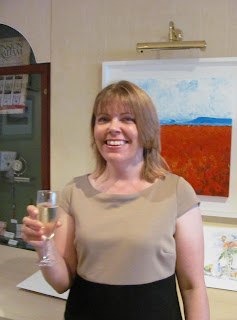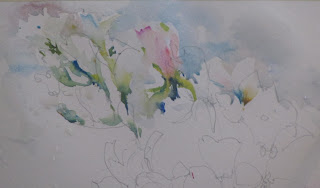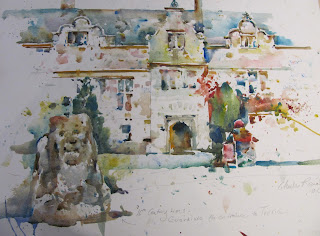It is now just over a week since we returned from Crantock and having completed the posts for each day I now turn to an overview. Without doubt is was excellent. This was my fourth with Charles and I felt more comfortable on it than any of the others. Since Urchfont two years ago I have put in a lot of effort and feel I have made progress so there is a faint light at the end of the tunnel - very faint! I intend to work hard over the next few months and try to consolidate the lessons learned. If you want to benefit from such experiences you do need to work at it. It is all too easy to regress.
The people on the course comprised 17 students, who in a few cases had brought non-painting partners with them. This included my wife who had been with me on our three previous Crantock visits with the artist Judi Whitton.
The group eagerly await Charles return from a break.
Charles back at work!
All attention!
Doug Cushman standing with Gilles .
Gilles took notes and also painted along with Charles, something he encourages. Difficult to do but Gilles managed it
As well as the pleasure of meeting Charles and Judy Reid once more it was great to see those artists I had met on previous courses. There were several on their first course, which is fairly unusual given the great demand for places with many coming year after year. I must not forget Jane Duke who is the organizer and a professional artist in her own right, holding workshops and also painting courses/holidays herself
www.janeduke.com On this occasion her husband Perry was with her and was one of the models for the portrait sessions.
Jane Duke
What of the artists on the course? As usual there was a mix of amateur and professional - and even semi-professional artists
possibly slightly fewer than previously. I don't know the exact status of everyone so apologies if I miss something out, or if you read this e-mail me and I will correct the information. It was nice to meet artists like Emily Stedman from New York
www.emilystedman.com/ once more, who was on both my previous UK courses.
Emily Stedman
Another distant visitor was Gilles Durand from France, an excellent professional
www.gillesdurand.fr/ who has received many awards in his own country. Gilles told me he had demonstrated at an exhibition in France where he was followed by Viktoria and Slawa Prischedko. Gilles was also at Burford and Urchfont and it was a pleasure to meet such a fine artist and nice man again.
Gilles Durand
Another course member who I had met at Burford was Doug Cushman, an American who has lived in Paris for the last ten years. Doug is an illustrator by profession
www.doug-cushman.com/ and can trace his ancestors back to the Mayflower. Doug and Mick Carney got on famously!
Doug - one last sketching opportunity- final evening!
Both Ian and Jane Wright are regulars on Charles courses although I don't know exactly how many they have attended, certainly many more than me. Both are good painters with Ian exceptional. I class him as a semi-professional see his website
www.artwright.co.uk/
Ian and Jane Wright
This wouldn't be complete without mentioning the Sunderland Express Mick Carney, literally the life of the party and a larger than life figure. Mick continues to astound me with the depths of his knowledge on a range of subjects including art and music. At the time of writing he is in Maine, USA connecting with the art world over there. He is shown here with Judy wife of Charles, who is the guiding light behind the scenes and front of house as well. Charles paints Judy does the rest.
Mick Carney and Judy Reid
There are many more to be mentioned like Margaret Chapman, who I first met on the Spanish course, Latifa Kostas the life and soul of the group (as well as Mick), another Charles Reid regular, met on my previous UK courses, Doreen Young from Burford and Urchfont, who originally persuaded Charles to come to England and arranged his courses for some years. There was also Lynn and Nigel Jenner from Jersey. Lynn was at Urchfont, and several first timers. To those whom I've not mentioned by name apologies as my main intention in writing the report was for those who, for different reasons, did not make it. Pauline from my local AVA group applied but it was already fully booked, only days after booking opened. I understand there is always a list of those hoping that a cancellation will enable them to attend.
I've mentioned Mick Carney previously. Mick has his own blog and is the reason I started mine, after I met him at Urchfont two years ago. I knew little about blogs until then. We have kept in touch ever since, and he stayed with us the night prior to travelling together to Cornwall, to break his 500 mile journey from the North-East. I am orginally from the North East and have family there.
What of the course itself? I have already said it was brilliant and I don't think anyone would disagree. There was plenty of hard work but also merriment so the atmosphere remained lighthearted, although always serious when it came to painting. I felt I benefited more this time because my painting has improved over the last two years and I was more able to absorb the lessons. Charles told my wife that I'd improved and Gilles Durand said something similar to me. Thank you both for being so encouraging. Will Charles return to England? See my next and final piece.
If you would like to see Mick's report, which is different to mine in that much of it is about the people, although the painting is well covered, go to his blog
www.thepaintingstruggle.blogspot.com/ There are also many more photos of the participants and is written with his usual verve. He is also a much better photographer. Indeed a man of many talents.
I haven't yet posted photographs of my paintings on the course. I was quite pleased with some of them and will do so in the next few days.




























































